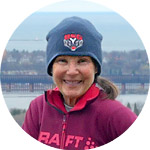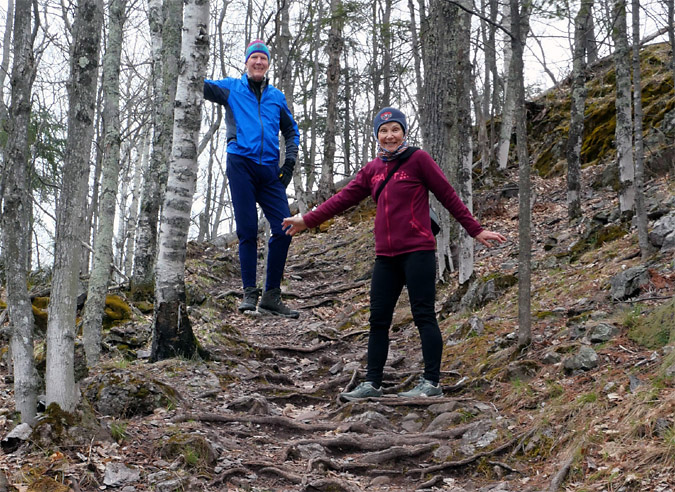My Cross Country Ski Training |
 |
This series shares my cross country ski training and racing, and this is Week 51 of my training and racing year, which started last May. During the last two weeks of the training year, since we are in a rest and recovery period, let's do a little analysis of the prior 50 weeks of training and racing.

First, about this week's images. My husband and favorite training partner Tom and I are out for a Sunday hike, enjoying this week's break from structured training. Look at the beautiful pattern of those roots on that trail! As for the top-of-page header image, that's me racing in a raging snowstorm during the Yellowstone Rendezvous cross country ski marathon.
This Year's Training Tallies
At the beginning of this blog, I explained that I planned to train for 500 hours a year, and that I chose that number of hours because I am interested in middle-distance races such as 10 to 30 kilometers, not marathons and not sprinting. I also noted that I have a spreadsheet that allows me to enter the number of hours per year and get a calculation of how many hours to train per week. In another blog page, I showed my hours-per-week and explained that the fluctuation in hours-per-week is designed to plan for stress and recovery as the year progresses.
Then, I also talked about the modes of training, such as running, roller skiing, cycling, kayaking, strength, and of course skiing, plus how the plan recommends allocating more time to on-snow and ski specific activities as winter approaches. So, after a year of training, we can find out:How many of my training hours were on-snow? I snow skied a little more than 123 hours. These hours were accomplished in 83 days of skiing.
How much classic skiing did I do this year? About 50 1/2 hours of classic skiing. These hours were accomplished in 34 days of classic skiing.
How much skate skiing did I do this year? About 73 hours of ski skating. These hours were accomplished in 49 days of skate skiing.
Dryland Season (Spring, Summer and Fall)
How about my time allocation during dryland training in spring, summer and fall prior to on-snow season?
- cycling 33 percent
- running 28 percent
- strength training 11 percent
- roller skiing 10 percent
- kayaking 8 percent
- and other activities (mostly hiking).
Snow Season
During snow season, my training time was split between the following modes of exercise:
- skating 40 percent
- classic skiing 25 percent
- running 16 percent
- strength training 9 percent
- hiking 8 percent
- and a smidgen of roller skiing and cycling.
As you can see, the above percentages tell that during snow season, my time spent running cut in about half. Then cycling, kayaking and roller skiing pretty much dropped off the map. As for strength training, these workouts dropped off a bit during race season, as planned.
There are many more tallies and percentages available on my training log spreadsheet; however, I just want to give you a flavor for how a cross country ski racer allocates their time.
Intensity Levels
Another topic for analyzing the year's training is intensity levels. If you have been following this blog, you know that the number of intensity sessions increases as Winter and race season approaches. However, an important guideline as part of my plan is that I am supposed to do about 80 percent of my training in an easy heart rate (referred to Level 1 or L1 heart rate). How did I do in this regard? Pretty spot on! Since I use a heart rate monitor, I recorded the heart rate levels pretty faithfully, especially for intensity workouts. Therefore, I can now look at how much of my time I spent in each heart rate zone. (For an explanation of heart rate zones L1 L2 L3 L4, see the KEY lower on this page.) For the entire year, my intensities tally up as follows:
- L1 80-81 percent of training hours were in this intensity level.
- L2 3 percent,
- L3 4 percent,
- L4 2 percent,
- Racing 3 percent This 3 percent was spent on 14 races, including 7 cross country ski races during winter (all skating except one classic skiing), plus 7 races during dryland season (running, kayaking and cycling),
- Strength 8 percent
Something interesting: If you add up the percentage of time I spent on intense training, which would be marathon pace or more, that shows that I spent about 9 percent of my training going hard. (That's the total of L3, L4, L5 and Racing in the list above.)
So, there we have it for my year end tallies. And now you may know a lot more than you did prior to reading my blog pages about cross country ski training. I hope you have enjoyed following this training year with me.
This blog is based on my cross country ski training, and the info. is provided just for those who are curious about the kind of training cross country ski racers enjoy doing to get ready for winter fun at Lake Tahoe and beyond. When all weekly posts are complete, this blog shows an entire training year, based on US Ski Association and professional coaching plans for middle distance cross country ski racers. It's the kind of detailed information I wish I had early on in my ski racing. So enjoy! You can view more of my training log by clicking on one of the navigation links below.
So let's check out Week 51:
| Week 51 | AM/PM | Mode | Workouts description: Goal hrs. 0 Spring Recovery all easy-to-L1. My coach's instructions: "It is really important to let your body REST after an entire year of training! Please really consider taking these two weeks completely OFF to let your body recuperate. If you have to get out, go for walks/hikes. This is also a great time to practice self recovery by stretching/yoga and deep tissue work with foam rollers, lacrosse balls etc." Therefore, I am taking that advice and doing my physical therapy exercises on a daily basis. Also, I will be doing hiking, super easy running and easy cycling, but for only easy outings of about an hour at a time. | Hours |
| Week Summary | 0:00 | |||
KEY: The references to L1, L2, L3 and L4 in the spreadsheet refer to heart rate zones, with L1 being lowest heart rate. A general way to think about these heart rate training zones is: L1 is Level 1 - very easy to talk, L2 is Level 2 - easy to talk, L3 is Level 3 - difficult to talk marathon race pace, L4 - cannot talk 5K race pace, L5 - WFO sprint pace maximum speed. Key to modes of training: Ski Walk/Bound SW/SS, Ski Skate SSK, Ski Classic SCL, Rollerski Skate RSSK, Rollerski Classic RSCL, Road Bike RdB, Mountain Bike MtB, Kayak or Row KYK, Double Poling DP, Weight Room/Strength WTRM. (For in-depth information about training plans, periodization of training and all the details that go into making up a training year, please look for CXC Academy or another training organization for that kind of detail.)
Waist pack with water bottle holder...
You have probably noticed that when I am out on the trails, I like to wear a waist pack with water bottle holder. Mine is made by Nathan Sports, but I have also found many really nice choices you can find on Amazon.
DISCLAIMER: All sports including Cross Country Skiing have inherent risks. This training page is provided as information only. It is not a prescription for training. It is provided without the benefit of assessing the reader's health, fitness or skill. It is not a substitute for qualified personal coaching. Obtain a doctor's medical assessment before engaging in strenuous exercise. By reading this page, you agree to indemnify the author and any associated entity from any harm you may incur if you decide to follow the training program, and you agree you are at your own risk and that you hold harmless the author and any other associated entity.
- First Woman Overall in the following races: Kneissel Rendezvous Marathon, President's Cup Marathon, Ridge to River Iron Woman, Pepsi Challenge 10K, two consecutive years: 10th Mountain Division Biathlon, and Muskoka Loppet
- First Woman Overall and First Mixed Team wins for three consecutive years: Ski to Sea and Ridge to River multi-sport races
- Second Woman Overall in the following races: Ski Jeep Challenge Series, Gatineau Loppet 27K Worldloppet Race, Superior Ski Classic Marathon, Grand Marnier Cup Marathon, Yellowstone Rendezvous Half-Marathon
- Third Woman Overall: Payette Lakes Ski Marathon
- U.S. Ski Association Cross Country Ski Championships results:
- 26th Place Women All Age Classes in 20K Freestyle
- 32nd Place Women All Age Classes (3rd in Class F30-39) 25K Freestyle at Royal Gorge
- 51st Woman All Age Classes 15K Classic at Lake Placid
- 2nd Woman Overall in the Masters Category Age 30 and up (First in Class F30-34) 20K Classic at Royal Gorge
- U.S Ski Association Masters Nationals results:
- First Woman Overall 25K Freestyle race
- 6th Woman Overall 10K Freestyle race
- 6th Woman Overall 20K Freestyle race
- American Birkebeiner 53K Worldloppet Race Elite Wave starter for two consecutive years finishing 22nd and 29th Woman Overall (5th in class F35-39 both years).
After moving to Lake Tahoe, Mary Kay won several Top 3 Woman finishes in Far West Cross Country Ski events. She joined U.S. Biathlon Association and won two consecutive years Overall Woman at the 10th Mountain Division Biathlon, and was runner-up in her third year. She won Top Gun at the Washington State Biathlon Championships, out scoring all men and women. Currently, Mary Kay is a member of Ishpeming Ski Club and frequent competitor in cross country skiing, bicycling and kayaking events.



